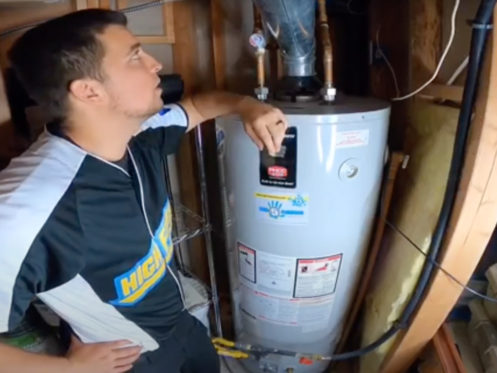The article listed below in relation to Tips on Maintaining a Water Heater is amazingly fascinating. Give it a go and draw your own assumptions.

Hot water is necessary for daily convenience, whether it's for a refreshing shower or washing meals. To guarantee your hot water system runs effectively and lasts much longer, regular maintenance is essential. This write-up offers functional tips and insights on just how to maintain your home's hot water system to prevent disturbances and costly repair services.
Intro
Maintaining your home's hot water system could seem difficult, however with a couple of simple steps, you can ensure it runs efficiently for years to find. This overview covers every little thing from understanding your hot water system to do it yourself upkeep tips and knowing when to employ specialist aid.
Value of Keeping Your Hot Water System
Regular maintenance not just expands the life-span of your hot water system but also ensures it runs successfully. Disregarding maintenance can lead to decreased effectiveness, greater power costs, and also early failing of the system.
Indicators Your Warm Water System Requirements Maintenance
Knowing when your hot water system needs focus can protect against significant issues. Look out for indicators such as irregular water temperature level, unusual noises from the heater, or corroded water.
Purging the Hot Water Heater
Flushing your water heater removes debris build-up, enhancing effectiveness and prolonging its life.
Monitoring and Changing Anode Rods
Anode rods prevent deterioration inside the container. Checking and replacing them when worn out is critical.
Complicated Problems Requiring Specialist Assistance
Examples include significant leaks, electrical troubles, or if your hot water heater is regularly underperforming.
Regular Specialist Maintenance Benefits
Specialist maintenance can include detailed assessments, tune-ups, and guaranteeing conformity with safety and security standards.
Evaluating and Changing Temperature Setups
Changing the temperature setups guarantees optimum performance and safety.
Do It Yourself Tips for Maintenance
You can execute a number of upkeep tasks yourself to maintain your hot water system in leading condition.
Looking for Leaks
Consistently examine pipelines and connections for leakages, as these can cause water damage and greater bills.
Comprehending Your Hot Water System
Before diving right into maintenance jobs, it's valuable to comprehend the basic elements of your hot water system. Normally, this includes the hot water heater itself, pipelines, anode rods, and temperature level controls.
Monthly Upkeep Tasks
Regular regular monthly checks can aid catch small issues before they rise.
Evaluating Pressure Alleviation Valves
Testing the stress safety valve ensures it works correctly and avoids too much pressure accumulation.
Shielding Pipes
Protecting warm water pipes decreases warmth loss and can save energy.
When to Call a Specialist
While do it yourself maintenance is advantageous, some problems call for specialist proficiency.
Verdict
Regular upkeep of your home's warm water system is vital for performance, durability, and price savings. By complying with these ideas and recognizing when to seek professional assistance, you can make sure a trusted supply of hot water without unexpected interruptions.
Water Heater Maintenance Tips
Test the TPR Valve
Shut off the power and the cold-water supply valve. Place a bucket under the pipe connected to the temperature-pressure-release (TPR) valve on the top or side of the tank. (This valve opens if the tank pressure gets too high.) Lift the valve’s tab to let some water out, then let go. If water keeps flowing, drain the tank partway, unscrew the old valve with a pipe wrench, and install a new one. Check the Anode Rod
Put a hose to the tank’s drain cock and let out a few gallons of water. Now fit a 1 1/16-inch socket onto the rod’s hex head on top of the heater (or under its top plate) and unscrew the rod. If it’s less than ½ inch thick or coated with calcium, buy a new one, wrap its threads with Teflon tape, put it back in the tank, and tighten securely. Use this segmented rod if headroom above the tank is limited. Drain the Tank and Wash Out Sediment
Drain the remaining water in the tank into the bucket, then stir up the sediment on the tank’s bottom by briefly opening the cold-water supply valve. Drain and repeat until clean water comes out of the hose. Close the drain cock, refill the tank, and turn its power back on. Adjust the Temperature
Find the temperature dial on the side of the tank and unscrew its cover. Adjust the dial to 120 degrees using a flathead screwdriver. For every 10 degrees the temperature is lowered, you can expect to save up to 5 percent in energy costs. Turn the water heater off or the thermostat down to its lowest setting if you plan to be away from home for more than three days. Insulate the Pipes
Buy some self-sticking 3/8-inch-thick foam pipe insulation that matches the pipes’ diameter. Slide the foam over the hot-and cold-water pipes as far as you can reach. Insulating the cold-water pipe prevents condensation in summer. Peel the tape and squeeze the insulation closed. If the pipe is 6 inches or less from the flue, cover it with 1-inch-thick unfaced fiberglass pipe wrap. https://www.thisoldhouse.com/plumbing/21016402/how-to-maintain-a-water-heater

Hopefully you liked our post about What Kind of Maintenance Do Water Heaters Need?. Thank you for taking a few minutes to read our piece of content. Those who enjoyed reading our blog posting kindly be sure to pass it around. I praise you for being here. Kindly come by our site back soon.
Click Here